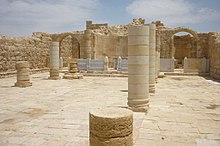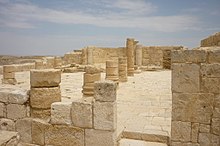Avdat National Park
Avdat ( Hebrew עבדת; Arabic عبدة) (also Abdah , Ovdat or Obodat etc.) is an Israeli national park in the Negev desert in southern Israel . Since the 4th century BC A city of the Nabataeans existed here as an important station on the Frankincense Route . The city of Avdat existed for over a thousand years until the Byzantine era . The name of the city is in Byzantine sources Οβοδα Oboda or Εβοδα Eboda . Today's national park with settlement remains from the Nabatean, Roman and Byzantine times was declared a UNESCO World Heritage Site Incense Route - Desert Cities in the Negev by UNESCO in 2005, along with other cities of Nabatean origin in Israel .
location
The National Park Avdat can be reached via the Israeli highway 40 and is located approx. 600 meters above sea level, above Wadi Zin , in a mountainous area, between the places Sede Boker and Mizpe Ramon , in the middle of the Negev desert.
history
Nabataean and Roman times
The Nabataeans founded in the 4th century BC The city of Avdat as a way station on the Frankincense Route, via which, in addition to spices, cosmetics and other valuable goods were delivered from the Far East via the Arabian Peninsula, the city of Petra and the Negev desert to the port cities of the Mediterranean Sea. The passing trade caravans moved from Arava via Mamshit on to Avdat, Nizana to ancient Gaza , the most important export port in the region. Avdat is said to have received its name from the Nabatean king Oboda II (also known as Obodas II), who lived at the beginning of the Roman era (reign 62/61 to 60/59 BC). He was worshiped as Zeus Oboda , according to an inscription in Greek on the southeast tower. This inscription also indicates that the tower was built in 294.
Historical sources from that time report that King Oboda II was buried in Avdat. The remains of two temples (on the west side of the settlement hill, south-west of the north church and east of the south church), a ceramic workshop, a military camp and remains of houses were found from this time. In the vicinity of a temple, inscriptions have been found which show that in addition to Zeus Oboda , the Greek goddess Aphrodite was worshiped, who corresponds to the Nabatean goddess Uzza , as well as the main Nabataean god Dushara . An inscription from the year 268 bears the dedication to All Friends of Oboda . The first remains of the settlement date from the 3rd century BC. When the initially nomadic Nabataeans settled down. The establishment and supply of localities was only possible due to a highly developed irrigation method, the so-called flash water irrigation . This enabled agriculture to be carried out even in arid regions.
In the 1st century AD, the economic focus shifted to agriculture. The Roman Empire annexed the Nabataean Kingdom in AD 106 and Avdat became a fortified border town of the Roman Empire.
Byzantine period
In the Byzantine era (4th to 7th centuries AD) Avdat experienced a second heyday. After the Nabataeans had adopted the Christian faith in the 4th century, magnificent churches and other buildings, including water cisterns, were built. The south church, which is consecrated to St. Theodoros , has had a monastery since the 6th century. Grave slabs made of marble bear inscriptions from 541 to 618. The monks also devoted themselves to the expansion of the irrigation systems and agriculture.
At that time the agricultural area was expanded and caves were carved into the rock on the slopes of the town, which were used to store agricultural products and as workshops. A large wine press from the late Roman or early Byzantine period testifies to the productivity of viticulture.
The ruins of Avdat that can be seen today show the remains of a Nabatean settlement and Nabatean tombs, a Byzantine bath with a 70 m deep well, a Roman villa, a Roman military camp, a pottery, remains of houses and farms outside the castle walls. In the center of the excavation site is a spacious, rectangular castle from the Byzantine era with partially restored walls and towers, a large cistern in the middle of the courtyard and the remains of a late Byzantine chapel on the north wall. A second courtyard adjoins to the west as a spiritual district, to which the two Byzantine churches, the north and south churches, are connected.
With the end of the Byzantine era, the invasion of foreign nomadic peoples, the capture of Avdat by the Persians (614) and the Arab conquest of the area, the decline of Avdat began in 636.
Since the 1950s , the old Nabatean-Byzantine irrigation systems have been reconstructed in an experimental farm , the Even-Ari Farm (after the botanist Michael Evenari ) near the ancient city of Avdat , and the agriculture based on them has been revived.
Archaeological exploration
The first archaeological excavations began in 1870 and have been systematically continued since 1953 by the Hebrew University of Jerusalem under the direction of Michael Avi-Yonah . This was followed by excavations from 1959 by Abraham Negev, from 1975 to 1977 also by Rudolph Cohen and since 1990 by Ofer Katz, Gil Tahal, Tali Erickson-Gini and Peter Fabian.
literature
- Avivit Gera: Avdat National Park. The Israel Nature and Parks Authority, January 2015 ( https://en.parks.org.il/ParksAndReserves/Avdat.Retrieved June 13, 2018).
- Birgit Borowski: Avdat . In: Israel . 4th edition. Karl Baedeker, Ostfildern 1991, ISBN 3-87504-507-6 , p. 126-130 .
Web links
- Incense Route - Desert Cities in the Negev on the UNESCO World Heritage Center website ( English and French ).
- UNESCO: The Incense Route - Desert Cities in the Negev. (PDF, 45 MB)
Coordinates: 30 ° 48 ' N , 34 ° 47' E









